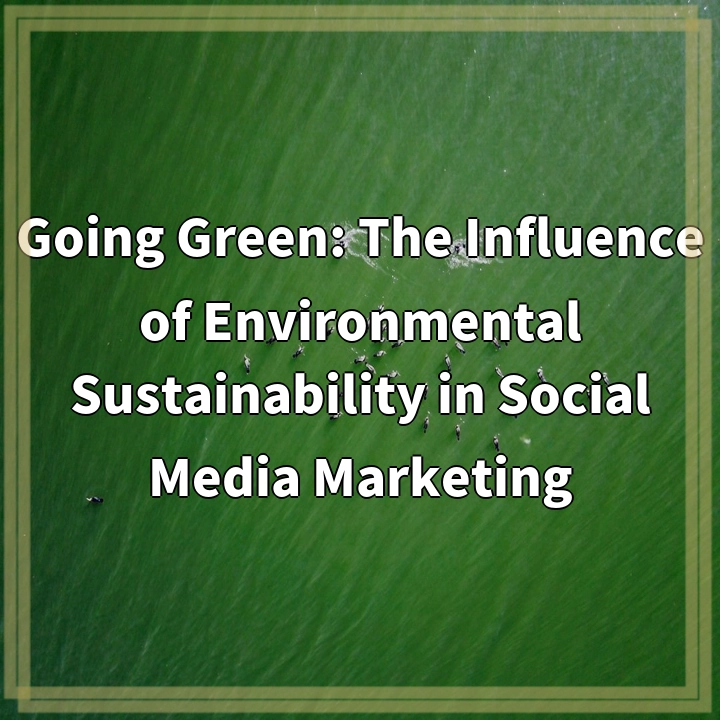
What it is:
Social media marketing has become an integral part of modern-day business strategies. With the increasing awareness and importance of environmental sustainability, businesses are now incorporating “going green” practices into their social media marketing efforts. Going green in social media marketing refers to the conscious effort made by businesses to align their marketing strategies with sustainable and eco-friendly practices.
Real-World Problems:
While the incorporation of environmental sustainability in social media marketing brings numerous benefits, it also presents some unique challenges and real-world problems. These problems include:
1. Greenwashing:
One of the major challenges in going green in social media marketing is the issue of greenwashing. Greenwashing refers to the deceptive practice of presenting a company or its products as more environmentally friendly than they actually are. Many businesses may use environmental buzzwords without implementing substantial sustainable practices, misleading consumers and damaging their brand reputation.
2. Eco-friendly product claims:
When businesses choose to promote their products or services as eco-friendly through social media marketing, ensuring the validity of these claims becomes vital. Consumers are becoming increasingly conscious of the environmental impact of their purchasing decisions and are more likely to support companies that offer genuinely sustainable solutions. The challenge lies in accurately communicating and substantiating these claims effectively.
3. Green marketing confusion:
With the rise of going green in social media marketing, many consumers are becoming overwhelmed with various eco-friendly marketing messages. This could lead to confusion about which brands are genuinely committed to sustainability and which ones are simply capitalizing on the trend without making a meaningful impact. Businesses must find innovative ways to differentiate themselves and provide authentic and transparent communication.
4. Measuring impact:
Quantifying and measuring the impact of environmental sustainability in social media marketing can be a complex task. It is challenging to accurately gauge the extent to which these efforts are influencing consumer behavior and driving positive environmental change. Developing appropriate metrics and analytical tools to measure the impact of going green in social media marketing is crucial for businesses to assess their sustainability efforts and make informed decisions.

Solutions:
While the real-world problems associated with going green in social media marketing may seem daunting, there are several solutions that businesses can implement to address these challenges:
1. Transparency and authenticity:
Businesses should prioritize transparency and authenticity in their environmental sustainability efforts. It is crucial to back up green marketing claims with concrete actions and evidence. Providing detailed information about sustainable practices, certifications, and partnerships can help build trust with consumers and differentiate from greenwashing practices.
2. Educate and engage consumers:
It is important for businesses to educate and engage consumers about the specific environmental impacts of their products or services. Sharing information through engaging content, such as blog posts, videos, and infographics, can help consumers make more informed choices. Engaging with consumers through social media platforms and addressing their concerns and questions can also foster trust and strengthen the brand’s credibility.
3. Collaborate with sustainability influencers:
Partnering with sustainability influencers can amplify the reach and impact of environmentally friendly marketing efforts. Collaborating with influencers who align with the brand’s values and have a genuine passion for sustainability can help spread the message to a wider audience and enhance credibility. Influencers can provide testimonials, reviews, and creative content that showcases the brand’s commitment to sustainability.
4. Measurement and reporting:
Businesses should invest in measuring and reporting the environmental impact of their social media marketing efforts. This can involve tracking metrics such as engagement, reach, and conversions generated by sustainable campaigns. Additionally, conducting lifecycle assessments and carbon footprint analyses can provide valuable insights into the environmental consequences of the brand’s activities, aiding in identifying areas for improvement and setting meaningful goals.
5. Collaboration across industries:
To tackle the challenges of environmental sustainability in social media marketing, collaborations and partnerships across industries can play a crucial role. By sharing best practices, knowledge, and resources, businesses can collectively work towards driving positive change and fostering a more sustainable future. Collaboration can also lead to innovative solutions and inspire other brands to adopt eco-friendly practices.















